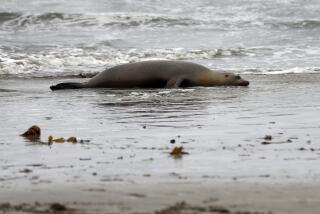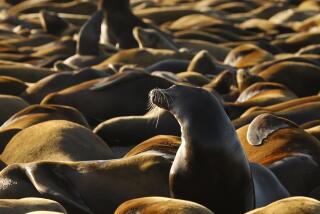Hopes Rising on Effects of Oil Spill as Efforts Begin to Rescue Wildlife
- Share via
VALDEZ — Three fishing boats loaded with a week’s provisions steamed from Valdez harbor Thursday morning in the first organized attempt to rescue oil-smeared birds, sea otters and other damaged wildlife from Prince William Sound.
As the skippers of the Dotty G., Ms. Jeanne and Silver Bullet headed toward Naked Island, scientists expressed cautious optimism about the unfolding situation despite Good Friday’s massive oil spill.
Bird death has appeared low so far, an encouraging sign both for immediate survival of the animal population and for the long-term effects of the spill.
“I’d say there’s a probability that the really catastrophic (effects) that we were afraid of, may not occur,” said Bruce Wing, a biologist with the National Marine Fisheries Service.
To Start Cleaning Animals
Injured animals were to be ferried by helicopter to a recovery facility in a small community college dormitory in Valdez. Volunteers expected to be cleaning oil-covered injured animals by this morning.
Virtually no one was certain that the rescue effort would succeed, or that earlier dire predictions might prove overly grim. Optimistic comments are invariably accompanied by warnings that every spill is different, that little data on this one is yet available, and that the Valdez spill is still in critical flux.
“This thing ought to settle down in a week,” said Dr. John Whitney, scientific support coordinator for Alaska’s Hazardous Materials Response Branch of the National Oceanic and Atmospheric Administration. “There’s a lot of floating oil out there right now. It could come ashore very easily with minor wind shifts, or minor wind velocity changes . . . . “
The weather was a significant factor. Throughout the day Thursday, the sun dropped in and out of clouds, and it was windy and in the low 20s on the water. But light rain and snow were forecast.
“Right now, we’re pretty lucky with the north wind. It’s going with the natural flow of the water out Montague straits. Big slugs of oil are headed out that direction, and if (the wind) stays up, it reduces the impact on the islands,” Whitney said.
Compared with other oil spills, the Valdez disaster has produced few early animal victims, and these evaded capture. The big flights of migratory birds through flyways here are weeks away, and an assessment released Thursday by John Piatt of the U.S. Fish and Wildlife Service showed that while as many as 200,000 marine birds are in the sound this time of year, they are widely scattered in flocks of 100 to 200.
All this has kept bird death low so far, and it has become another encouraging sign for the long haul.
However, Wing, a Juneau-based biologist, is concerned about fish. Again, no one yet knows how the herring-roe or salmon catches will fare this year, at least until the spill stops moving. But as Wing pointed out: “Some of the long-term effects could be very localized. By that I’m saying that they could occur only in a small bay--and two bays down the line, it might not have any impact.”
Wing said it might take some areas 10 to 15 years for chum salmon to recover; 5 or 6, for pink salmon.
Al Maki, senior environmental scientist with Exxon, owner of the tanker that went aground and unleashed the biggest oil spill in U.S. history, repeatedly notes that oil is “a natural material.”
While he conceded that, “certainly, it’s not a natural material in the ocean where we’ve got it now,” he said, “you have to remember that oil itself is originally the result of marine deposition. That’s where it was formed . . . .
“That makes it at least amenable to biodegradation. I mean, the environment can assimilate the material.”
Maki said that Exxon intends to see that long-term studies are performed on Prince William Sound.
Wing, observing the recuperative powers of nature, said that when a Mexican bay was swamped with oil from a beached tanker some years ago, the sea urchin population was destroyed. He said that quite quickly a bed of kelp, no longer fed on by urchins, took its place. Fifteen years later, colleagues who visited the site told him, the kelp was still in control.
This is the sort of tale that makes Cindy Lowry, Alaska regional director of Greenpeace, particularly uneasy.
“The problem I have,” she said, “is that 10 years from now things may look the same, and things will still be alive, but I think we’re going to see some resident populations like our killer whale population that aren’t going to stay here. If there aren’t any sea lions, there isn’t food, they’ll be gone.”
Researchers have identified just about every whale in Prince William Sound, according to Tom Loughlin of the National Marine Mammal Laboratory in Seattle.
“Everybody knows who’s out there,” he says, “who swims with whom, the resident pods and transient pods. Of all the animals (in Prince William Sound) they will be the easiest to assess” to see if the population has declined.
Loughlin also speculates that the whales will mostly survive, though he agreed that they may move to other waters.
Loughlin also speculates that the whales will mostly survive, though he agreed that they may move to other waters. He is more concerned with the pregnant sea lions and harbor seals of the sound, worried that premature births and spontaneous abortions could cripple their colonies for some time.
But in the short term, the otters are most at risk.
“To my knowledge, this is the first spill that actually threatens otters,” said Randall Davis, an otter specialist at Hubbs Marine Research Center in San Diego.
Uses Results of Study
Davis has set up shop at the college dormitory and plans to use the results of his three-year study of otter cleaning techniques, using Dawn, the dish-washing detergent.
Alice Berkner, who describes herself as “just a duck scrubber,” also uses Dawn to clean fouled waterfowl. Berkner is founder of the Berkeley-based International Bird Rescue Research Center and is in Alaska to assist with the cleanup.
The danger to oil-soaked otters is hypothermia. Oil destroys the loft, the dead air formed in an otter’s fur, and brings the animal’s skin in contact with the icy seawater. An otter has a high metabolic rate, requiring a quarter of its body weight in food daily. Under the stress of such great cold, an otter might have to eat half of its body weight (a near impossibility) to survive. With cleaning, rinsing and proper food, many otters can be expected to recover in a week.
But Thursday night, the first photos of dead animals began appearing on the evening news.
More to Read
Sign up for Essential California
The most important California stories and recommendations in your inbox every morning.
You may occasionally receive promotional content from the Los Angeles Times.










